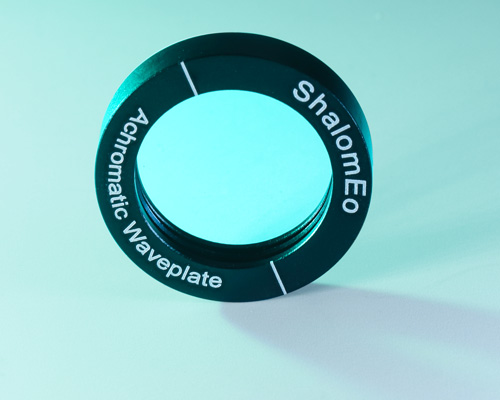
| Code | Wavelength | Retardation | Aperture | Mount | Unit Price | Delivery | Cart |
|---|---|---|---|---|---|---|---|
| 2081-001 | 450-650nm | λ/4 | 18mm | Diameter 25.4mm (1") | $280.0 | 4 weeks | |
| 2081-002 | 450-650nm | λ/2 | 18mm | Diameter 25.4mm (1") | $280.0 | 4 weeks | |
| 2081-007 | 650-950nm | λ/4 | 18mm | Diameter 25.4mm (1") | $280.0 | 4 weeks | |
| 2081-008 | 650-950nm | λ/2 | 18mm | Diameter 25.4mm (1") | $280.0 | 4 weeks | |
| 2081-003 | 690-1200nm | λ/4 | 18mm | Diameter 25.4mm (1") | $280.0 | 4 weeks | |
| 2081-004 | 690-1200nm | λ/2 | 18mm | Diameter 25.4mm (1") | $280.0 | 4 weeks | |
| 2081-005 | 900-2000nm | λ/4 | 18mm | Diameter 25.4mm (1") | $280.0 | 4 weeks | |
| 2081-006 | 900-2000nm | λ/2 | 18mm | Diameter 25.4mm (1") | $280.0 | 4 weeks |
An Achromatic Waveplate is a special kind of Zero Order waveplate, comprised of two waveplates made of two different birefringent materials (e.g., crystal quartz and magnesium fluoride). The existence of chromatic dispersion greatly affects the refractive indices of materials. The two birefringent materials which construct the achromatic waveplates have complementary birefringent properties that could attenuate the chromatic dispersion effects so that excessive shifts of retardation over wavelength change in the first waveplate could be counterbalanced by the second waveplate. This results in a virtually flat response of phase delay over a broad wavelength band (usually hundreds of nanometers), therefore achromatic waveplate is an excellent choice for applications such as tunable laser sources, femtosecond laser systems, spectroscopy, and other systems concerning broadband light sources.
The two most common phase retardation values are lambda/2 and lambda/4 retardation, half waveplates could be applied to rotate vertical polarization into horizontal polarization and vice versa, while quarter waveplates could be used for the conversion of linear and circular polarization.
Shalom EO offers Achromatic Half Waveplates and Achromatic Quarter Waveplates with AR coatings. The two constituent plates, one made of single-crystal quartz, and one made of magnesium fluoride (MgF2), are either cemented together using NOA61 (Norland Optical Adhesive 61, an optical grade adhesive) or with an architecture of an air gap in between. NOA61 is a high-performance adhesive with great bonding strength, high heat resistance, and excellent clarity to support optical applications under various operation conditions, and Shalom EO only applies the glue outside the clear aperture of the waveplates. Achromatic waveplates with an air-spaced design are coated on all faces, then mounted on opposite sides of a spacer, and placed within a cell, to form an air gap between the quartz waveplate and the MgF2 waveplate. The air-spaced modules have particularly promoted damage threshold greater than 500 MW/cm^2, and are adaptive to high power lasers.
Off-the-shelf achromatic waveplates are available for online shopping in Shalom EO. The standard achromatic waveplates are of half or quarter retardation, with three optional wavelength ranges: 450-650nm, 690-1200nm, and 900-2000nm covering the visible, and a portion of the infrared Spectral. Fast dispatch and economized pricing are guaranteed. If you have any other specific requirements, Shalom EO also provides custom services where all the parameters can be tailored to suit your demand.
FAQs:
Here are some typical questions and answers about waveplates that might be helpful for buyers. The contents below are a summarized version, please check our Introduction to Waveplates and Retarders if you want to learn more.
How does a waveplate work?
Waveplates and Retarders are important optical components to manipulate and alter the polarization state of laser light.
Waveplates are conventionally made from birefringent crystals such as Quartz and magnesium Fluoride. (There are also Retarders made from non-birefringent materials. The Fresnel Rhomb Retarder is an excellent example, which is usually made from BK7, UV Fused Silica, or ZnSe, realizing the phase delay by utilizing the Total Internal Reflection. The retardation generated by a Fresnel Rhomb depends virtually solely on the refractive index and the geometries of the prism. )
The anisotropy of these crystal materials results in the separation of one light beam into two light rays when hitting the interface. The two split light rays encounter different refractive indices: one called the Ordinary Ray, which is governed by the ordinary refractive index, and another called the Extraordinary ray, which is governed by the direction-sensitive extraordinary refractive index. The two rays always have their polarization direction perpendicular to each other.
Waveplates are purposefully sliced so that their optical surface is parallel to their optical axis. The ordinary ray and the extraordinary ray will experience different refractive indices and hence travel in different phase velocities. The axis where the polarized electric vector travels with a greater velocity (Vfast=c/Nfast) is the Fast axis. The one in which the electric vector travels with a lower velocity (Vslow=c/Nslow) is the Slow axis. The two axes are always orthogonal.
When a light beam is projected normally to the surface of a waveplate, different phase velocities of the two components will naturally introduce phase delay between the fast and the slow components, where the slow components will be several phases (or a fraction of phase) lagged behind the fast component. The magnitude of the phase delay is called Retardation. The retardation of a waveplate could be formulated as below:
Retardation=2πL(Nslow-Nfast)/λ
Where L is the distance traveled by the incident light (the thickness of the waveplate), Nfast and Nslow are the refractive indices along the fast and slow axis respectively.
The value of retardation might be written in various forms, for example, a “half-wave” retardation is equivalent to a retardation value of π radians or lambda/2.
From the equation above, it could be easily deduced that by deliberately designing the thickness of the waveplates, the desired retardation could be obtained. However, besides the thickness of a waveplate, other external factors will affect the retardation value, for example, the wavelengths of the incident light, the temperature of the operation environment, the angle of incidence, etc. The changes in retardation caused by external factors are often disturbing and detrimental and are what the manufacturers trying their best to avoid.
Finding the Axes?
Finding the fast axis of each waveplate is a critical step when using the waveplates. The mounted waveplates offered by Shalom EO are all designed with their fast axes indicated as a straight light on the mount. While the fast axis of the unmounted versions is all marked directly on the waveplates. However, if the axes are not indicated or the indications are blurred, there is a simple method to help you find the axes which apply for waveplates with all values of retardation. First, place a polarizer in front of the laser device, tilt the polarizer until the light is extinct, then interpose the waveplate between the laser device and the polarizer, rotate the waveplate so that the eventual light output is still extinct——and viola! you have found an axis successfully!
Adjustments?
Additionally, you might find the waveplates you bought might not produce exactly the designed retardation. There are plenty of reasons: e.g. the waveplates are not designed for your wavelength of interest, or there are external factors such as temperature affecting the retardation. The small deviations could be modified by rotating the plane of polarization towards the fast or slow axis of the waveplate. Moving towards the fast axis reduces the retardation while moving towards the fast axis raises the retardation. Try both directions and keep checking the improvements using polarizers.
Specifications:
| Material | Quartz+MgF2 | Wavelength (Standard) | 450-650nm, 690-1200nm, 900-2000nm |
| Retardation | λ/4 or λ/2 | Aperture | 18mm |
| Surface Quality | 20/10 S/D | Parallelism | <1 arc Sec |
| Retardation Tolerance | < λ/100 | Damage Threshold | >500 MW/cm^2 |
| Coating | AR coating | Mounted Diameter | 25.4mm (1 inch) |
Retardation Curves:
The following graphs illustrate the retardation of Achromatic Waveplates over the wavelength ranges
1. 450-650nm Achromatic Quarter Waveplates and Half Waveplates

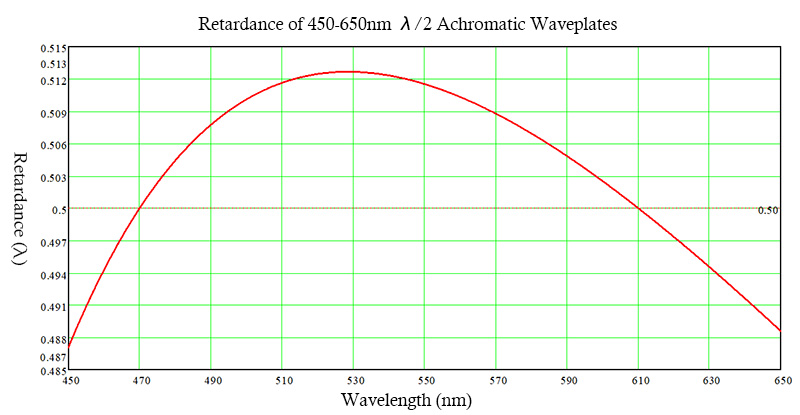
2. 690-1200nm Achromatic Quarter Waveplates and Half Waveplates

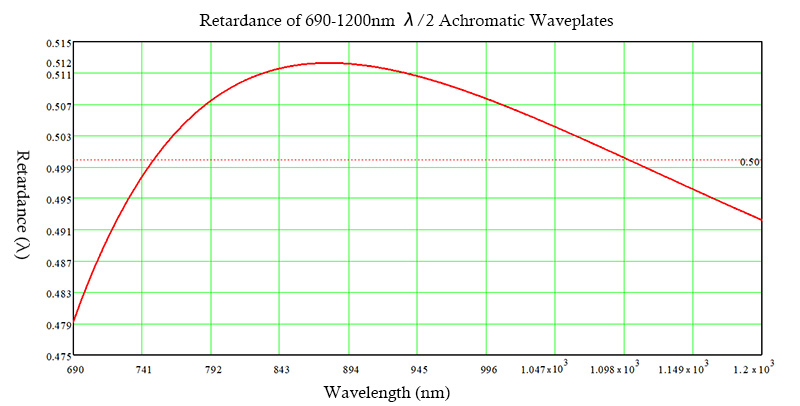
3. 900-2000nm Achromatic Quarter Waveplates and Half Waveplates
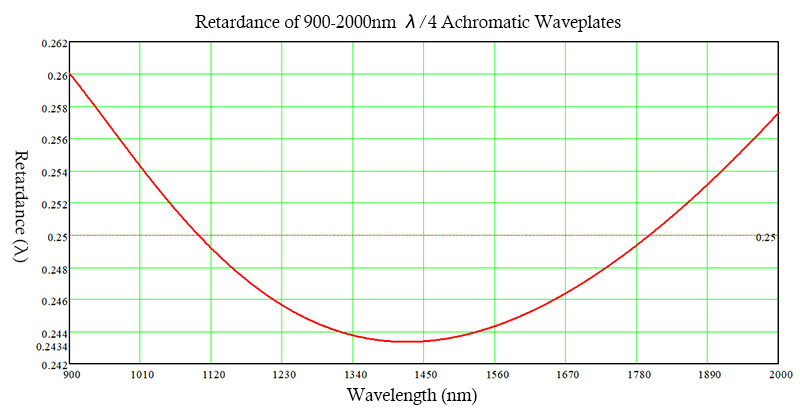
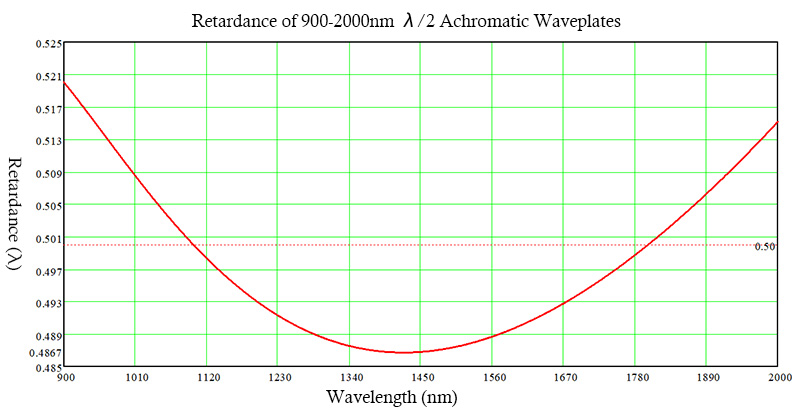
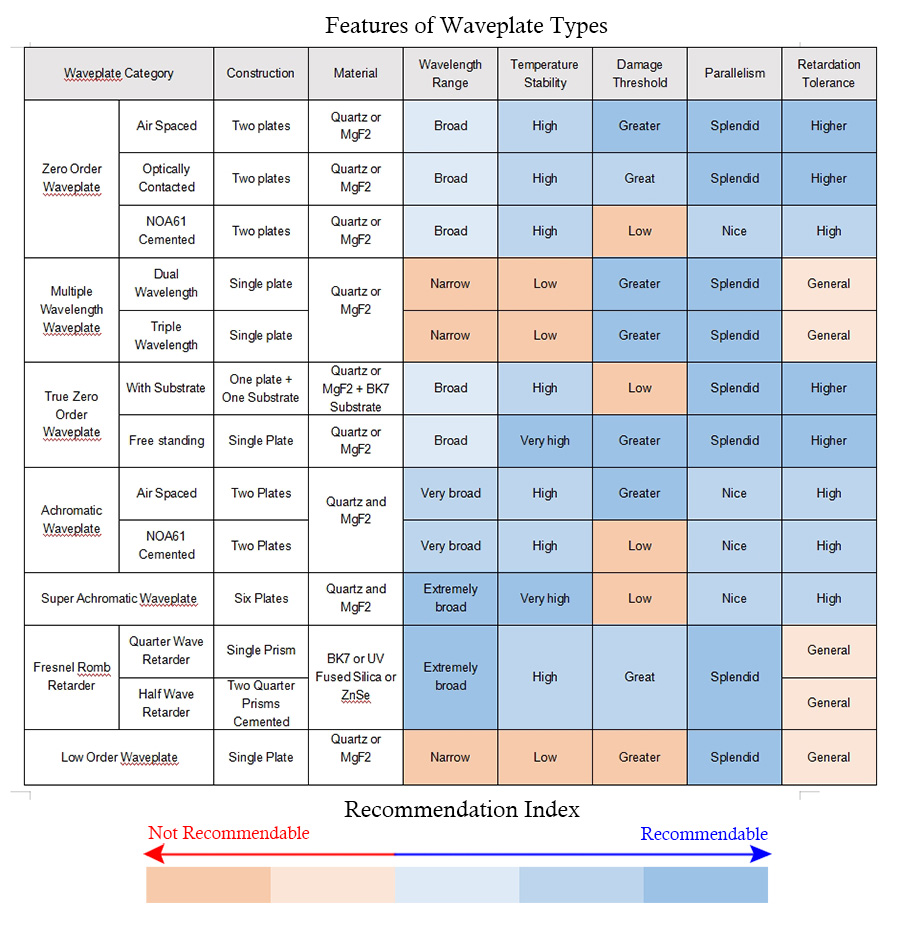
Understanding different types of Waveplates and Retarders are equally as important as figuring out their working principle, especially for buyers. Don’t worry, Shalom EO edited a brief guide for you, after reading that you might have a much clarified and profound understanding of waveplates.
Low Order Waveplates or Multiple Order Waveplates
Due to difficulties in the manufacturing stage, it could be hard to churn out large quantities of waveplates that are ultra-thin and which produce exactly the desired fractional retardance. The Low Order Waveplates, Or Multiple Order Waveplates are relatively thick and generate the desired retardation with several additional wavelengths of phase delay. Because light waves repeat themselves periodically, a low order half waveplate, which produces a phase delay of lambda/2 plus 3 additional lambdas could also function as a half waveplate. The word “Order” here refers to the number of additional wavelengths generated. In this text, a low order waveplate is better than multiple order waveplates because it produces less addition phase delay and its retardation is more precise. However, the surplus of retardation also implies that they are much more sensitive to changes in wavelengths, temperature, or the AOI than their zero order counterparts.
Generally speaking, if you are looking for cheap buying-in-bulk waveplates for single wavelength applications, then Low Order Waveplates are just right for you. Shalom EO offers Low Order Waveplates of two material options (Quartz for Visible to Near-IR spectral or MgF2 for greater wavelengths up to 7000nm).
Zero Order Waveplates
Zero Order Waveplates are essentially comprised of two multiple order or low order waveplates with their axes orthogonally aligned (aligning the fast axis of one waveplate to the slow axis of the another), the resulting retardation is the difference between two individual retardations produced by respectively by the two constituent waveplates. By combining two single waveplates together, Zero Order Waveplates effectively offset the impacts of external factors (wavelength change, ambient temperature) on the retardation, which means the retardation will be much more constant compared to the low order waveplates, making them competent for applications involving broadened wavelength. Nevertheless, they might still have rather susceptive responsiveness to variations of the angle of incidence.
Shalom EO offers three types of Zero Order Waveplates: Air spaced Zero Order Waveplates, Optically Contacted Zero Order Waveplates and NOA61 Cemented Zero Order Waveplates. While the cemented zero order waveplates are the common alternative, for high energy operations, consider Air spaced zero order waveplates and optically contacted zero order waveplates, since the two types have relatively higher damage threshold than the cemented versions.
True Zero Order Waveplates
True Zero Order Waveplates are waveplates of single-plate structure and provide exactly the required retardation, therefore its thickness is usually only several micrometers. Although requiring relatively strict processing, the contracted thickness contributes to more superior retardation constancy against wavelength variations or climate changes than conventional Zero Order Waveplates. Shalom EO offers True Zero Order Waveplates made from Quartz (for 532-3000nm) or MgF2 (for long-wavelength applications from 3000-7000nm), the single plate versions are relatively fragile but are of high damage threshold, while the versions cemented with BK7 substrates are much easy to handle, but are of lower damage threshold.
Achromatic Waveplates
Achromatic Wavepltes are constructed by one MgF2 Waveplate and one Quartz Waveplates with their axes orthogonally aligned, of which the birefringent properties are complementary, achieving the required focal length while minimizing chromatic dispersion. Through this approach the intrinsic influence of wavelength shifts on the retardation is drastically reduced, making achromatic waveplates even more retardation-constant than zero order waveplates, thus eminent for various Broadband applications spanning wide spectral ranges (e.g. from 900-2000nm). Two application examples are Tunable laser sources, Femtosecond laser systems, etc.
Super Achromatic Waveplates
Super Achromatic Waveplates are virtually an upgraded version of achromatic waveplates. The operation principle of super achromatic waveplates is the same as that described of achromatic waveplates. Super achromatic waveplates are also compounded by two crystal materials (e.g. quartz and magnesium fluoride), but instead of two as in the case of achromatic waveplates, they consists of six single waveplates (three of Quartz, three of MgF2), the result is exceedingly flat retardation over even wider wavelength ranges.
Fresnel Rhomb Retarders
Fresnel Rhomb Retarders operates upon an entirely different principle other than exploiting the birefringence. A Fresnel Rhomb introduces phase difference between the components of light using total internal reflection. When light is projected on the interface, the electric field of the light wave splits into two perpendicular components, the s component, and the p component. The rhombs are strategically processed into the shape of a right parallelepiped, so that with the angle of incidence cautiously chosen, the p component will proceed lambda/8 relative to the s component at each total internal reflection underwent. When light emerges, after experiencing two total internal reflections, the p component will eventually be lambda/4 ahead of the s component, thus realizing the same function of a Quarter Waveplate. When constructing a Half Wave Fresnel Rhomb Retarder, two rhombs are cemented in tandem to avert reflections at the interface.
The Fresnel Rhombs are usually made from glass materials, which are non-birefringent, the typical three being BK7, UV Fused Silica or ZnSe. Because the retardation introduced by the rhomb is related to the refractive index, which only varies slightly over a wide wavelength range, the Fresnel Rhomb Retarders have even broader wavelength capabilities than other broadband waveplates such as achromatic waveplates.
Dual Wavelength Waveplates
Dual Wavelength Waveplates introduce two retardation values for two wavelengths through the fitting of the refractive index at different wavelengths. Dual Wavelength Waveplates are particularly useful when used in conjunction with other polarization-sensitive components to separate coaxial laser beams of different wavelengths or elevate and promote the conversion efficiency of Solid State SHG Lasers. Additionally, Dual Wavelength Waveplates could also be applied to THG Systems. Triple Wavelength Waveplates could also be customized by Shalom EO at your request.